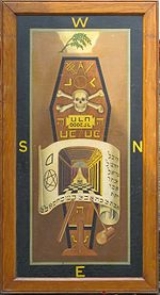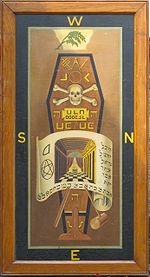
Tracing board
Encyclopedia
Tracing boards are painted or printed illustrations depicting the various emblem
s and symbols of Freemasonry
. They can be used as teaching aids during the lectures that follow each of the three Masonic Degrees, when an experienced member explains the various concepts of Freemasonry to new members. They can also be used by experienced members as self-reminders of the concepts they learned as they went through their initiations.
 The Masonic tracing board took several decades to develop into its pictorial form. Initially a chalk drawing was made on the table or floor in the centre of the hired tavern room in which a Masonic Lodge met, the work being executed either by the Tyler or Worshipful Master. Evidence suggests that a simple boundary in the shape of a square, rectangle (or "double square"), or a cross was drawn first, with various Masonic symbols often of a geometric type (e.g., circle, pentagram, etc.) were drawn later, the former usually being drawn by the Tyler and the latter possibly by the Master. Later various symbolic objects, (such as a ladder, beehive, etc.,) were added and sometimes drawings were interchangeable with physical objects.
The Masonic tracing board took several decades to develop into its pictorial form. Initially a chalk drawing was made on the table or floor in the centre of the hired tavern room in which a Masonic Lodge met, the work being executed either by the Tyler or Worshipful Master. Evidence suggests that a simple boundary in the shape of a square, rectangle (or "double square"), or a cross was drawn first, with various Masonic symbols often of a geometric type (e.g., circle, pentagram, etc.) were drawn later, the former usually being drawn by the Tyler and the latter possibly by the Master. Later various symbolic objects, (such as a ladder, beehive, etc.,) were added and sometimes drawings were interchangeable with physical objects.
At the end of the work a new member was often required to erase the drawing with a mop, as a demonstration of his obligation of secrecy.
Though the various Grand Lodge
s were then generally hostile to the creation of any physical representations of the Ritual and symbols of the Craft, the time-consuming business of redrawing the symbols at every meeting was gradually replaced by keeping a removable "floor cloth" to display the symbols, and of which different portions might be exposed according to the agenda .
By the second half of the eighteenth century the Masonic symbols were being painted on a variety of removable materials ranging from small marble slabs to canvas, to give a more decorative and elaborate symbolic display.
By the mid-nineteenth century tracing boards had become fairly common, and a variety of different forms and designs survive, some to be diplayed on the floor and others vertically. Sets of three boards, corresponding to the three degrees, are now an accepted, though unofficial, part of Craft Freemasonry, and there are sometimes tracing boards in other degrees. As different Masonic jurisdictions established official, or standard, degree rituals the creation of new tracing boards by Freemasons waned and has since all but entirely disappeared in favour of standard designs.
Emblem
An emblem is a pictorial image, abstract or representational, that epitomizes a concept — e.g., a moral truth, or an allegory — or that represents a person, such as a king or saint.-Distinction: emblem and symbol:...
s and symbols of Freemasonry
Freemasonry
Freemasonry is a fraternal organisation that arose from obscure origins in the late 16th to early 17th century. Freemasonry now exists in various forms all over the world, with a membership estimated at around six million, including approximately 150,000 under the jurisdictions of the Grand Lodge...
. They can be used as teaching aids during the lectures that follow each of the three Masonic Degrees, when an experienced member explains the various concepts of Freemasonry to new members. They can also be used by experienced members as self-reminders of the concepts they learned as they went through their initiations.
History and development

At the end of the work a new member was often required to erase the drawing with a mop, as a demonstration of his obligation of secrecy.
Though the various Grand Lodge
Grand Lodge
A Grand Lodge, or "Grand Orient", is the usual governing body of "Craft", or "Blue Lodge", Freemasonry in a particular jurisdiction. The first Masonic Grand Lodge was established in England in 1717 as the Premier Grand Lodge of England....
s were then generally hostile to the creation of any physical representations of the Ritual and symbols of the Craft, the time-consuming business of redrawing the symbols at every meeting was gradually replaced by keeping a removable "floor cloth" to display the symbols, and of which different portions might be exposed according to the agenda .
By the second half of the eighteenth century the Masonic symbols were being painted on a variety of removable materials ranging from small marble slabs to canvas, to give a more decorative and elaborate symbolic display.
By the mid-nineteenth century tracing boards had become fairly common, and a variety of different forms and designs survive, some to be diplayed on the floor and others vertically. Sets of three boards, corresponding to the three degrees, are now an accepted, though unofficial, part of Craft Freemasonry, and there are sometimes tracing boards in other degrees. As different Masonic jurisdictions established official, or standard, degree rituals the creation of new tracing boards by Freemasons waned and has since all but entirely disappeared in favour of standard designs.

